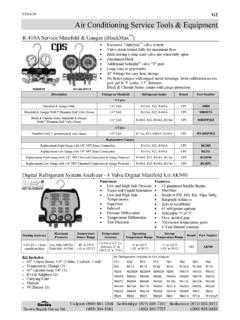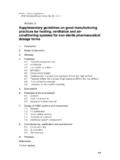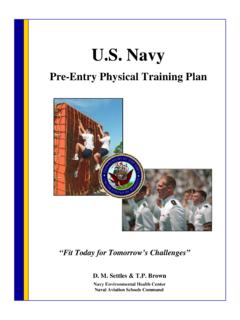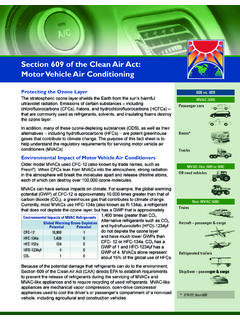Transcription of REFRIGERATION & AIR CONDITIONING GUIDE
1 [Type text] REFRIGERATION & AIR CONDITIONING GUIDE compressor TROUBLESHOOTING GUIDE : Understanding the Cooling Cycle 4/17/2009 A1 compressor , Inc. Horace Park A1 compressor , Inc compressor trouble shooting GUIDE CONFIDENTIAL QMF - 49 2 REFRIGERATION & AIR CONDITIONING GUIDE A p r i l 1 7 , 2 0 0 9 DYNAMICS OF COMPRESSION compressor TROUBLESHOOTING GUIDE INDEX 1. Introduction: Function of compressor 2. Super Heat 3. Charging A System 4. Oils 5. REFRIGERATION Controls 6.
2 Accumulators 7. Suction Line Filters 8. What is a BTU? 9. Thermostatic Expansion Valves 10. Relay and Cap Assemblies 11. Pump Down Systems 12. compressor Failures 13. Installing a New compressor 14. How to Install a New compressor 15. Brazing & Welding 16. Glossary 17. REFRIGERATION Cycle 18. Frequently Asked Questions 19. Tecumseh Pressure Control Settings 20. 06E Semi-Hermetic compressor Diagram (Press CTL + click to follow the hyperlink ) A1 compressor , Inc compressor trouble shooting GUIDE CONFIDENTIAL QMF - 49 3 REFRIGERATION & AIR CONDITIONING GUIDE A p r i l 1 7 , 2 0 0 9 1.
3 FUNCTION OF A compressor The function of a compressor is the same for either REFRIGERATION or A/C. It is really very simple. You are essentially transferring heat from one place to another; cooler, freezer or room. You are never adding are removing heat. Transferred by low pressure (low temp) Refrigerant in the evaporator and moving it to the condenser where it is High Pressure High Temperature. Usually, the fan moves the lower temp air across the super heated refrigerant high condenser coil cooling it.
4 This is where you feel the heated air. This is the heat removed from the room, cooler or freezer along with the heat of compression from the compressor . This brings me to the next part of compressor function: refrigerant flow. Starting at the discharge line at the compressor you will notice that this is the smallest line and should be the hottest one of the two that is connected to the compressor . The Discharge Line takes the hot refrigerant from the compressor to the condenser where it is cooled changing it from a hot refrigerant to a sub cooled liquid.
5 As the liquid leaves the condenser it will usually go to a receiver tank then to the liquid line sometimes straight to the liquid line depending on the expansion device. The next stage in the process is the Drier. The Drier removes the moisture and debris, if any, from the refrigerant. All Driers have an arrow on them. The arrow should always be pointed toward the evaporator and away from the condensing unit. The Expansion Device follows. There are usually only 3 types: 1. Capillary type; 2. Expansion Type; & 3.
6 Orifice Type. Regardless of the type, they all do the same thing---Drop the Pressure which lowers the temperature of the liquid refrigerant below the temperature of the room or box. The cold liquid now enters the evaporator unit, which is located inside the room or box, travelling through the coil where a fan usually blows warmer air across the cold refrigerant boiling it like water on a stove. The cold liquid picks up the heat of the box and at the end of the coil is only a super heated vapor. The super heated vapor travels to the low side of the compressor .
7 This line is the coolest and largest one that is connected to the compressor . Now the compressor sucks the low pressure refrigerant vapor pushing it to a high pressure high temp Vapor where it started its cycle all over again dissipating the heat it has removed from the evaporator. Back to the Index A1 compressor , Inc compressor trouble shooting GUIDE CONFIDENTIAL QMF - 49 4 REFRIGERATION & AIR CONDITIONING GUIDE A p r i l 1 7 , 2 0 0 9 2. SUPER HEAT SUPER HEAT EXPLAINED Say Super Heat to a mechanic and they will act like they know what it is but often they really don t understand.
8 Here I will explain what Super Heat is, how to find it and how to set it in simple English. Simply, Super Heat is the temperature of the Suction Line at any given point and the suction pressure converted to temperature (see temp / pressure chart or even the conversion temp inside your gauges R-22, etc.). The difference is Super Heat. The Suction Line temp will be the same or higher ..It can never be colder than the Chart temp. This chart temp is also the Evaporator Temp. Subtract the conversion chart temperature from the Suction Line Temperature and the difference is SUPER HEAT.
9 So, let s measure the suction of an A/C unit using R-22. For example purposes, let s say it measures 58 deg. F and we have a 65# suction pressure. Look either at the Green R-22 temp inside the suction gauge or look at your Refrigerant Temp Pressure Chart and you will see that 65# suction is 38 deg F. The difference between the 58 deg F we measured to the 38 deg F chart temp is Super Heat or, in this example, 20 deg F of Super Heat. So, what does this mean? Twenty (20) degF of Super Heat at the compressor is ideal.
10 It means that somewhere up the suction line the Liquid Refrigerant has changed to all vapor. All REFRIGERATION and A/C Compressors are designed to pump vapor not liquid. If the Super Heat is too low, 10 deg F or less, and you will run the risk of damaging the compressor . Low Super Heat will either thin the oil so it doesn t do its job or it enters the cylinder and can t get out fast enough. Either way, rods break and you are changing out a compressor . If the Super Heat is too high the compressor will run hot.







